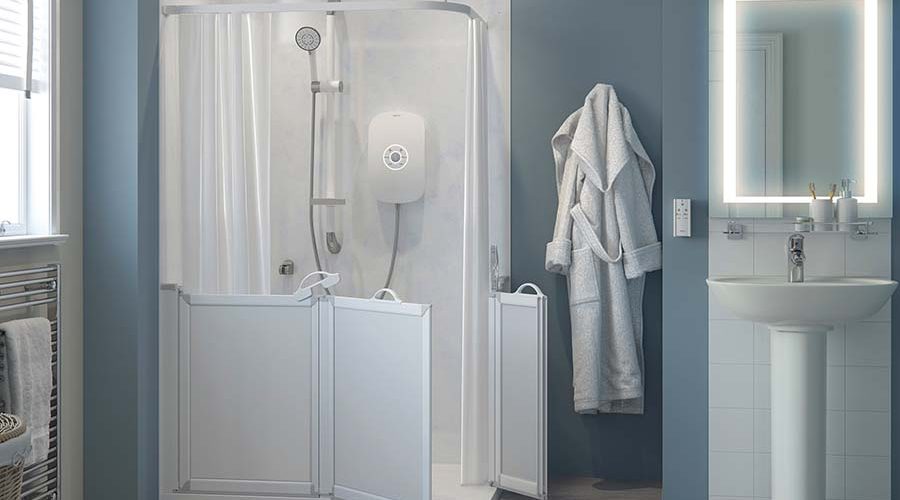The bathroom is a particularly high fall risk area, where good lighting is essential. Surprisingly though, very little attention is paid to it when an accessible bathroom refurbishment is carried out. Here Stuart Reynolds, Head of Product and Marketing at AKW, discusses what ‘good lighting in an accessible bathroom’ looks like and shows how one local care organisation in Merseyside has put good lighting into practice, to reduce falls and other accidents in inclusive bathrooms in their city.
AKW Ltd.
What is good lighting for accessible bathrooms?
In a traditional bathroom, lighting is often associated with creating a look and feel in the space; be that crisp and contemporary, or warm and welcoming. However, when it comes to accessible bathrooms, the key thing to consider is the set of limitations that that particular user has and how to meet their needs. In the majority of accessible bathroom installations, an IP65 LED bulkhead is traditionally specified for use. Although this is highly adequate for lighting the space for general use, it doesn’t allow users with specific challenges, such as mobility challenges, visual impairments or dementia the extra help that they need.
For those with low vision or mobility issues, the avoidance of shadows, dark areas and glare are key to safe movement around a bathroom. With this in mind, a mix of ambient and narrow beam lighting is ideal. As to the types of lights and their positioning, AKW has worked with occupational therapists to create a simple-to-use guide on what to install and where, for maximum user benefit.
In summary, the key points of the guide are:
- Include ambient lighting to maintain general light levels. This can be achieved with the use of LED ceiling lights, as these provide shadow-free illumination and are ideal for those with visual impairment challenges, or dementia.
- Include narrow beam LED downlights over specific ‘task-based areas’ such as the shower, bath, sink or toilet. Most LED downlights on the market have a beam angle of 60°; however, for those with low vision or mobility issues, a specialist task light with a 30° beam angle is best. This is because it delivers more ‘light where it is needed’ for the user.
- AKW’s Task Focused Lighting Kit has been developed to help anyone looking to install lighting in an accessible bathroom. The kit contains everything needed for a standard-sized bathroom, but additional items can be added for larger spaces.
Accessible bathroom lighting in practice in Merseyside
The St Helens Council’s Private Sector Housing department works hard with tenants and landlords to improve housing conditions in homes across the borough of St Helens, Merseyside. On hearing of the challenges faced by a disabled resident with additional visual impairment challenges, the department worked with AKW, one of the UK’s leading providers of accessibility solutions, to include a new lighting scheme in the accessible bathroom refurbishment, promoting the resident’s safety and independence.
As well as ensuring housing standards are upheld, the Private Sector Housing department also advises landlords on best practice to help accommodate those with specific accessibility requirements. As part of this remit Technical Officer, Ioannis Leontaris, was tasked with specifying an accessible bathroom for a private residence, that not only accommodated the resident’s mobility challenges but addressed their visual impairment limitations as well. Following talks with AKW, where the company’s new Task Focused Lighting Kit and ‘occupational therapist-advised lighting guide’ were discussed, Ioannis decided to recommend the lighting be used on this particular wetroom bathroom refurbishment.
Spotlight on lighting
Alongside the replacement of the bath with a wetroom, new tiling, flooring and a moveable shower seat, the lighting was installed using the occupational therapist-advised AKW lighting guidelines. The inadequate existing lighting was replaced with two long-lasting, bright (1764lm) ambient LED ceiling lights for general illumination. In addition, five narrow beam (30º) ceiling LED task lights were installed: three over the shower area and one over both the basin and toilet.
Following a request from Ioannis, the lighting was split into three different zones, with each operated by a separate light switch. The first switch controlled the toilet and basin task lights, the second was for the showering area, and the third operated the general illumination LED ceiling lights. The reason for the lighting zoning was so that the resident could have options regarding brightness, depending on their reason for visiting the bathroom.
Laura Walsh, Sales Business Development Manager at AKW, explains further: “Adequate light levels are essential for any bathroom, but even more so when the user has vision and mobility challenges. By combining very narrow beam, highly-focused task lighting and high light level ambient lighting in the same kit; shadows, dark areas and glare in accessible bathrooms can be eradicated, ensuring safe movement around the space.”
Ioannis Leontaris, Technical Officer at St Helens Council’s Private Sector Housing department, comments: “Our overarching mission is to improve the housing conditions in homes across the borough of St Helens. My work involves advising landlords and offering specific advice in relation to adaptations. I am pleased to say that this recent wetroom refurbishment has led to a dramatic improvement in bathroom accessibility for the resident. She is able to choose what level of brightness she wants in the bathroom, dependent on the task that she wants to undertake. The mix of ambient fittings, task-focused lighting and zone switches have been a real success.”
For those looking for further guidance on this subject, AKW’s Task Focused Accessible Bathroom Lighting Guide, developed in conjunction with occupational therapists, is available as a free download.








